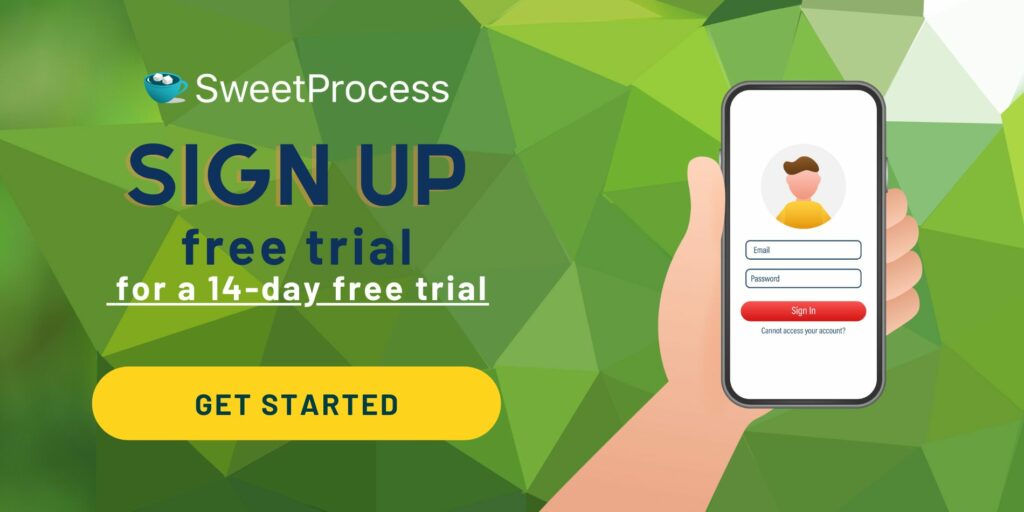Last Updated on March 28, 2025 by Owen McGab Enaohwo
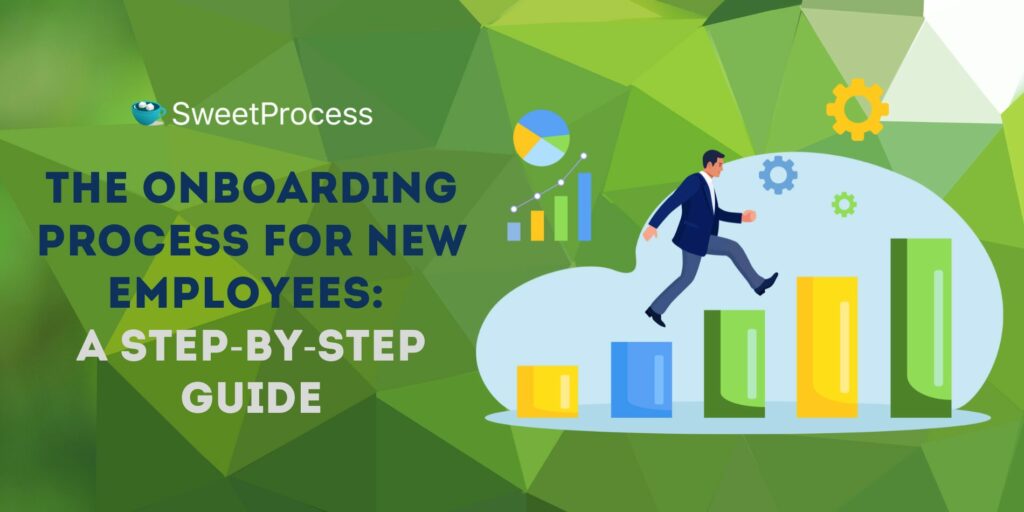
How beneficial is a good onboarding process for your new employees? Fifty-one percent of employees say they’d go “above and beyond” if given a good induction and onboarding.
That’s more than half of your new workforce eager to exceed expectations simply because you took the time to welcome and integrate them effectively.
In this guide, we’ll walk you through a step-by-step approach to creating an effective onboarding program that fosters employee loyalty and ignites their passion for your company.
Ready to streamline your onboarding process and ensure your new employees hit the ground running? Try SweetProcess free for 14 days, no credit card required.
What You’ll Learn In This Post:
What Is the Employee Onboarding Process?
Why Does the Onboarding Process Matter?
9 Key Steps to Create an Effective Onboarding Process
The 4 Phases of the Employee Onboarding Process: A Workflow That Works
How to Onboard New Employees Quickly and Easily Using SweetProcess
How to Ensure a Seamless and Positive Onboarding Process Experience
10 Best Practices for a Successful New Employee Onboarding Process
Common Challenges You Might Encounter During the Employee Onboarding Process
Employee Onboarding Process Template: What You Need for a Successful Onboarding
How to Measure the Success of Your Onboarding Process
Onboard New Employees Seamlessly Using SweetProcess
What Is the Employee Onboarding Process?
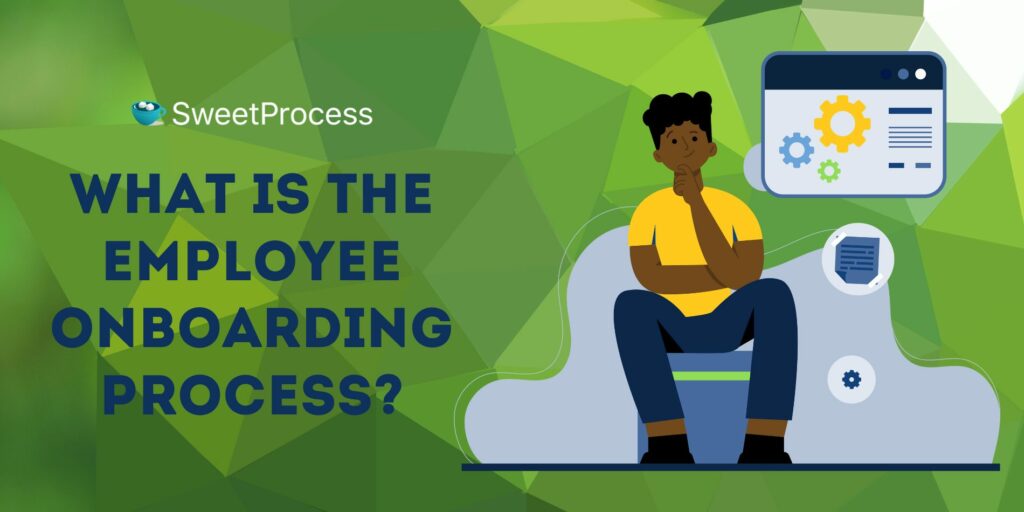
The employee onboarding process is a structured series of onboarding steps to integrate new hires into your organization.
The onboarding process starts when a new employee accepts a job offer. It ends when the new employee fully integrates into the company and its culture.
It involves a combination of administrative tasks, training sessions, introductions to team members, and socialization opportunities.
The goal is to create a smooth transition for new hires, reduce their anxiety, and accelerate their time to productivity.
A well-designed onboarding process helps new employees understand your company culture, values, and expectations while providing them with the tools and knowledge they need to excel in their roles.
Is it different from orientation?
Yes, onboarding and orientation are different.
Employee orientation is a one-time event or a short series of events that occur within the first few days of employment. It provides new hires with basic information about your company, its policies, and procedures. Orientation includes:
- Company overview and history
- Introduction to company culture and values
- Review of employee handbook and policies
- Completion of paperwork (tax forms, benefits enrollment, etc.)
- Office tour and introductions to team members
Onboarding, on the other hand, is a more comprehensive and ongoing process that can last for several weeks or even months. It goes beyond the basics covered in orientation. Onboarding includes:
- Job-specific training and development
- Goal setting and performance expectations
- Regular check-ins with managers and mentors
- Socialization and team-building activities
- Opportunities for feedback and support
Why Does the Onboarding Process Matter?
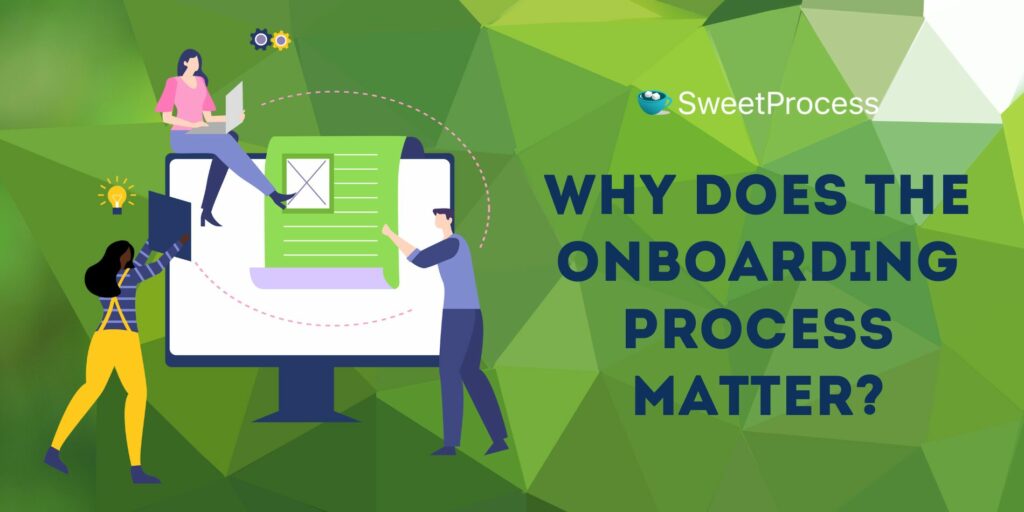
A well-structured onboarding process is a strategic investment in your new hires. Here’s why it matters:
1. Drives engagement and accountability
A comprehensive onboarding process helps new employees understand their roles, responsibilities, and expectations from day one.
When your employees know what is expected of them, they will be more engaged and take ownership of their tasks. This clarity fosters a sense of accountability, empowering them to contribute effectively to the team’s goals.
2. Gives new hires time to learn
Starting a new job is overwhelming, with a lot of information to absorb and skills to learn.
A structured onboarding process gives new hires the time and resources to understand their roles, the company’s products or services, and the tools they’ll be using.
Onboarding sets new employees up for long-term success by allowing them to learn at a manageable pace.
Data also shows that companies with a well-structured onboarding program increase productivity by over 70%.
3. Builds a positive work culture
A thorough onboarding process sets the tone for a new employee’s experience within an organization.
For example, if your company prides itself on collaboration, onboarding could include team-building activities or opportunities for new hires to shadow different departments.
By intentionally weaving this company culture into the onboarding experience, you create a sense of belonging and connection from day one. New hires feel valued, understand their role in the bigger picture, and are more likely to embrace and contribute to the positive work culture you’ve established.
4. Enhances the employee experience
The onboarding experience will shape an employee’s perception of your company and its role.
When new hires feel welcomed, supported, and valued from day one, they will be more satisfied with their jobs, engage more, and perform better overall.
5. Reduces turnover rates
Investing in a strong onboarding process can significantly reduce turnover rates. Studies show that organizations with a strong onboarding process experience can increase retention by 82%.
This helps prevent early turnover and the associated costs of recruiting and training replacements.
6. Helps to attract talent easily
When a company is known for its comprehensive and supportive onboarding program, it becomes more attractive to top talent.
Candidates are more likely to choose an organization that invests in their success and provides a positive employee experience.
Word-of-mouth recommendations and positive online reviews can make your company more appealing to potential candidates, making recruitment easier and more cost-effective.
7. Increases employee productivity
The faster new hires get up to speed, the sooner they can contribute to the company’s goals. A well-organized onboarding process accelerates this process, providing new hires with the knowledge and tools they need to be productive from day one.
Research shows that organizations with a strong onboarding process improve new hire productivity by 70%.
9 Key Steps to Create an Effective Onboarding Process
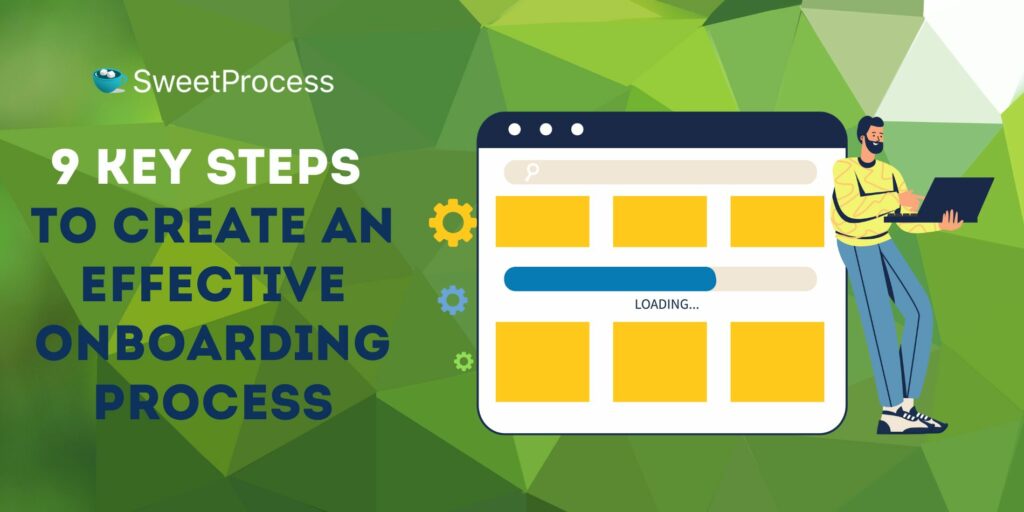
Before we get into the steps, remember that a successful onboarding process is not a one-size-fits-all process. It should be tailored to your company’s specific needs and culture.
However, several key steps serve as a foundation for creating an effective program.
1. Determine what new hires need to know
The first step is identifying the essential information new employees need to know to perform their jobs effectively.
Before the employee’s first day, compile a list of essential information they need.
Put together your company history, values, mission, organizational structure, products or services, and industry-specific knowledge relevant to their role. You can deliver this information through a combination of presentations, documents, and videos—we’ll show you how to do this using a platform like SweetProcess.
2. Outline logistical requirements
Next, outline the logistical aspects of onboarding, such as setting up workstations, providing necessary equipment (e.g., computers, phones), and creating email accounts and system logins.
Coordinate with IT, HR, and other relevant departments to ensure a smooth process.
For example, create a checklist of tasks to be completed before the new hire’s first day, such as ordering business cards, setting up their workspace, and assigning them a mentor.
3. Identify who the new hires should meet
The third step is introducing new hires to key individuals they will interact with regularly.
Introduce them to their immediate team members, managers, mentors, and colleagues from other departments. Organize one-on-one meetings or informal gatherings to facilitate introductions and build rapport.
4. Create an onboarding timeline
Develop a structured onboarding timeline that outlines the activities and milestones for the new hire’s first few weeks or months.
Why is this important? Many people work well with deadlines or structured timelines.
Structured timelines provide a clear end goal and help individuals focus on the task and you can achieve this using a timeline template.
5. Provide information on company policies and benefits
Make sure to provide new employees with a comprehensive overview of your company’s policies, procedures, and benefits.
They should be well-versed in company policies, including attendance, dress code, time off, and other relevant regulations. They should also be provided with comprehensive information about their benefits package, such as health insurance, retirement plans, and other perks. Consider creating a handbook or online resource where they can easily access this information.
6. Provide more information about the role and expectations
Clearly defining the new hire’s role and responsibilities helps set clear expectations from the beginning, reducing confusion and ambiguity about what is required of them.
Studies show that 86 % of employees with role clarity reported high levels of effectiveness, and 83% reported high levels of productivity.
Communicate the new hire’s job responsibilities, performance expectations, and success metrics. Provide them with a detailed job description and discuss how their role contributes to the team and company’s goals. Set up regular check-ins with their manager to provide guidance, feedback, and support.
7. Help form social connections with colleagues and mentors
You should always make sure you have a tight-knit team in your organization. Team members are more likely to share ideas, ask for help, and work together to solve problems.
Socialization is a crucial part of the onboarding process.
Encourage new hires to connect with their colleagues through team lunches, after-work activities, or mentorship programs. Building relationships with peers and mentors will help new hires feel more comfortable and supported, increasing engagement and satisfaction.
8. Induct into the organizational culture
Company culture plays a significant role in employee retention and satisfaction.
Help new hires understand the company’s values, traditions, and social norms. Share stories about the company’s history, successes, and challenges. Encourage them to participate in company events and activities to understand the organization’s unique personality.
9. Facilitate training
The last step is to provide new hires with the training and resources they need to perform their jobs effectively.
Training is an ongoing process, but it’s crucial during onboarding.
Provide new hires with comprehensive training on their job-specific skills and company-specific software or processes. You can do this through formal onboarding and training sessions, online courses, or on-the-job shadowing.
Also set up regular assessments to gauge their progress and identify areas where additional support may be needed.
The 4 Phases of the Employee Onboarding Process: A Workflow That Works
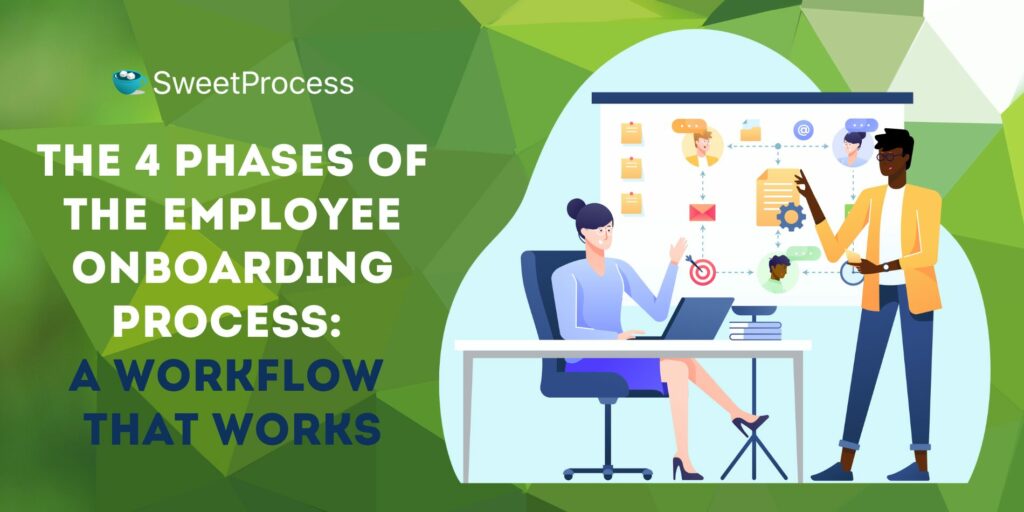
The employee onboarding process consists of four key phases. This structured approach lets you focus on specific goals and activities at each stage.
Here’s the four-phase workflow that covers all the crucial aspects of onboarding, from before the new hire’s first day to their long-term success.
Phase 1: Pre-onboarding
Pre-onboarding starts when a candidate accepts a job offer and continues until their first work day.
The primary focus of pre-onboarding is to prepare the recruit, encourage excitement for their new job, and foster employee engagement from day one.
Statistics show that up to 4% of new hires leave a job after a bad first day, and 22% of turnover happens within the first 45 days.
This pre-onboarding prevents this. It reduces the likelihood of the employee leaving too soon.
During the pre-onboarding phase, prepare for their arrival and ensure a smooth transition.
- Send the new hire necessary documents, such as tax forms, employment contracts, and NDAs, to be filled out before their start date.
- Arrange for their workspace, equipment, and system access. Coordinate with IT, facilities, and other relevant departments to ensure everything is ready for their first day.
- Share resources like employee handbooks, company policies, and benefits information so the new hires can familiarize themselves with the organization before starting.
- Choose a team member as the new hire’s go-to person for questions and guidance during their first few weeks.
Phase 2: Introductions
The orientation phase, known as the introduction phase, lasts about a week.
This phase focuses on familiarizing the new hire with the work environment, expectations, and team dynamics.
New employees are introduced to senior management, key team members, and the company’s values, policies, and safety procedures.
The most important aspect of this phase is the introduction to the company culture. By sharing the organization’s mission, vision, and values, new hires can better understand the context in which they will be working and how their role fits into the bigger picture.
Key activities in this phase include:
- Showing the new hires around the office, introducing them to their team members, and helping them settle into their workspace
- Arranging an informal gathering to help them build rapport with their colleagues
- Ensuring they understand the company’s expectations and guidelines
- Discussing their role, setting clear goals, and establishing performance expectations
Phase 3: Settling in
The settling-in phase lasts for the first few months of employment.
During this phase, new hires receive the necessary training to perform their job responsibilities competently. This training includes job-specific skills, company processes, software systems, and other tools essential to their role.
In addition to training, the settling-in phase involves ongoing support and feedback.
Managers and colleagues are crucial in helping new hires navigate their roles, providing guidance, feedback, and encouragement as they settle into their new positions.
During this phase:
- Provide in-depth, role-specific training and professional development opportunities to help the new hire build their skills and knowledge.
- Schedule regular one-on-one meetings with the new employee’s manager to provide guidance, answer questions, and offer constructive feedback on their progress.
- Work with the new hire to set short-term and long-term goals and establish clear performance expectations. Monitor their progress and provide support as needed.
- Encourage new employees to participate in company events, join employee resource groups, and engage with their colleagues to fully immerse themselves in the organization’s culture.
Phase 4: Follow up
The follow-up phase is an ongoing process. It continues beyond the initial onboarding period.
During this phase, you provide ongoing support, feedback, and development opportunities for new hires as they settle into their roles within the organization.
Managers and HR professionals should communicate regularly with new hires to check their progress, address any concerns or challenges, and provide feedback on their performances.
During the follow-up phase:
- Evaluate their performance, provide feedback, and set new goals.
- Offer training sessions, workshops, or conferences to help them expand their knowledge and skills.
- Discuss their career aspirations and create a plan for their professional growth within the company.
- Gather feedback on your employees’ onboarding experiences and use it to improve your process for future hires.
How to Onboard New Employees Quickly and Easily Using SweetProcess
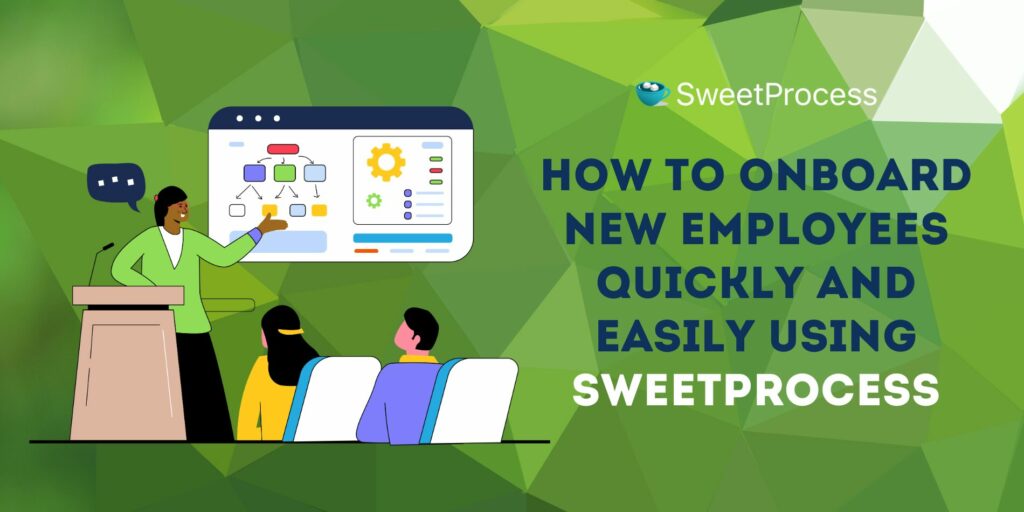
Trying to onboard new hires manually is time-consuming and complex, especially for growing companies.
However, with a tool like SweetProcess, you can streamline the experience, ensuring a smooth transition for new hires.
SweetProcess lets you create a centralized repository for all onboarding materials, including documents, videos, checklists, and training modules. This ensures that new hires have easy access to all the information they need in one place.
You can also use SweetProcess to automate repetitive tasks, such as sending welcome emails, assigning onboarding tasks, and collecting feedback.
Here are more ways how you can use SweetProcess:
Document and manage your company’s policies in one place
With SweetProcess, you can create a centralized repository for all your company’s policies, procedures, and documentation.
New hires can easily access this information without searching multiple sources or relying on colleagues for guidance.
According to a survey report by APQC, the average knowledge worker spends about 8.2 hours each week searching for the information they need to do their jobs effectively. That’s a significant amount of time that could be better spent on more productive tasks, especially for new hires already facing a steep learning curve.
You can drastically reduce this wasted time by using SweetProcess to store and manage your policies. New employees can easily search for and find the information they need.
How do you do this in SweetProcess?
- First, you’ll click on the “Policies” tab in your SweetProcess account. This will take you to the policy management page, where you can view all your existing policies and create new ones.

- To create a new policy, click on the “Create Policy” button in the top right-hand corner of the page. You’ll be prompted to enter a title for your policy, such as “Social Media Guidelines” or “Remote Work Policy.”


- Next, select which teams or departments the policy applies to. This is important for ensuring that the right people have access to the right information. For example, if you’re creating a policy related to customer service, you can make it accessible to your customer support team but not necessarily to your marketing or engineering teams.
- Once you’ve selected the appropriate teams, click “Continue” to move on to the policy content editor. This is where you’ll write out the details of your policy. SweetProcess provides a user-friendly interface for formatting text, inserting images or videos, and creating bulleted or numbered lists.
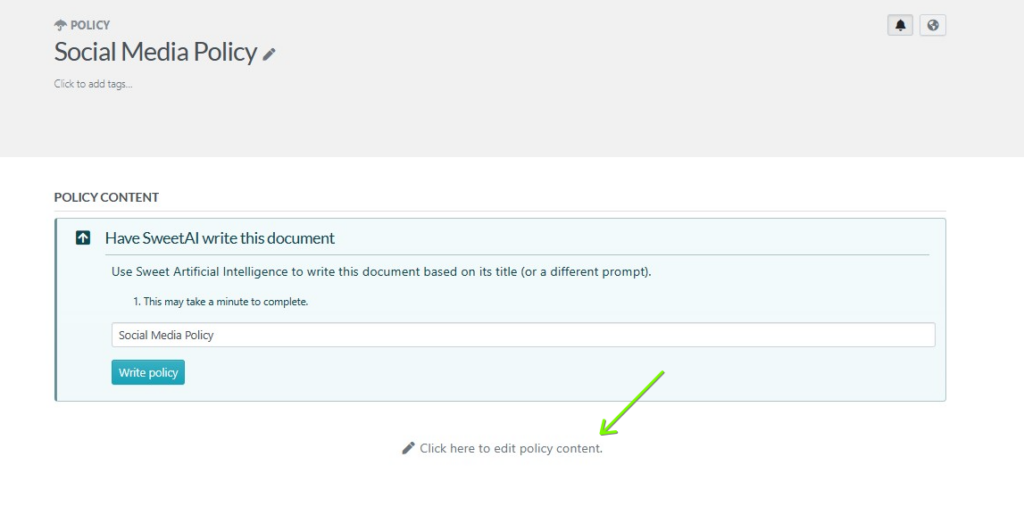
Let’s say you’re creating a policy on employee performance reviews. Include sections on the frequency of reviews, the criteria that will be used to evaluate performance, and the process for delivering feedback. As you write, use clear, concise language that will be easy for your employees to understand.
- When happy with your policy, click “Save Changes” and “Approve” to make it live. If you don’t have approval rights, click “Request Approval” to notify the appropriate manager or administrator.

Your policy will now be stored securely in SweetProcess, which is easily accessible to anyone who needs it.
You can add and update these policies as your company grows and evolves.
Create an internal knowledge base for employees
When you’re onboarding new employees, they’re often bombarded with a lot of information all at once.
From company policies and procedures to team dynamics and project details, there’s much to absorb quickly.
A centralized knowledge base allows new hires to revisit important information whenever needed without relying on their managers or colleagues to remind them.
According to a McKinsey report, a searchable record of knowledge can reduce the time employees spend searching for company information by as much as 35%.
Moreover, a well-organized knowledge base helps new employees feel more confident and empowered. Instead of constantly asking questions or making mistakes, they can proactively search for the information they need and find answers on their own.
This saves time and helps foster a sense of independence and self-sufficiency.
How do you create a knowledge base using SweetProcess?
- Click the “More” dashboard link to reveal a drop-down menu.
- From the drop-down menu, click on the “Knowledge Bases” button.

- On the new page that loads, click on the “Create Knowledge Base” button.

- Enter a title for your knowledge base, such as “Employee Orientation Resource,” and click the “Continue” button.

Once you click “Continue,” you’ll be taken to a page where you can customize various settings and options. Here’s what you can do:
- Choose a theme: SweetProcess offers several pre-designed themes, or you can create your custom theme to match your brand’s look and feel.
- Control access: Decide whether you want your knowledge base to be public (accessible to anyone) or private (requiring a login to view).
- Set up feedback options: Choose whether to ask team members or members of the public for feedback at the end of each article and whether to include a contact form for additional questions or comments.
- Customize text blocks: Edit the text that appears throughout your knowledge base, such as the search placeholder, breadcrumb navigation, and contact form labels.
- Set up categories: Create categories to organize your knowledge base content, such as “Common Help Topics,” “Onboarding,” or “Customer Service.”
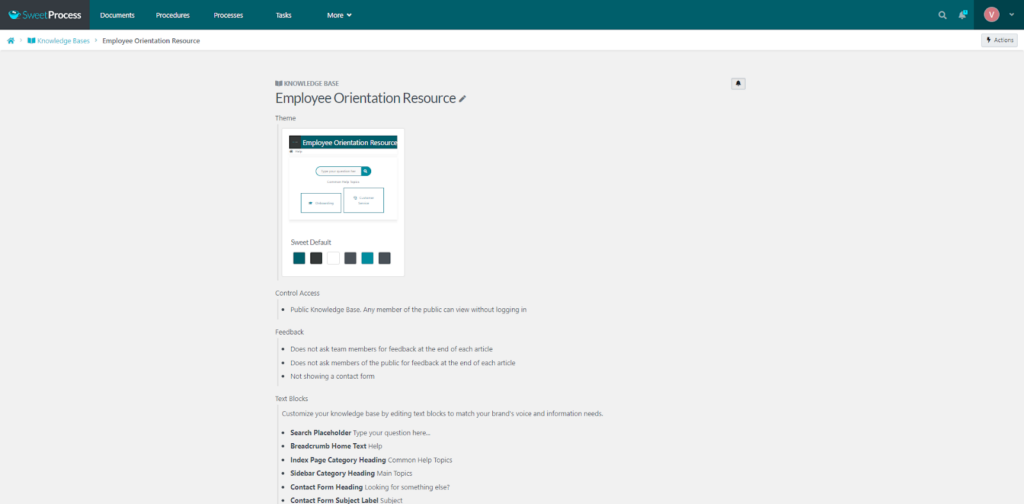
Once you’ve customized your settings, you can add content to your knowledge base.
You can add articles on company policies, tutorials on using specific employee onboarding software and tools, or FAQs on common topics.
Expert Tips
- When creating content, ensure your knowledge base is easy to navigate and search. Use clear, descriptive titles for your articles and categories, and include relevant keywords throughout the text to help employees find what they’re looking for.
- As your company grows and evolves, add and update content in your knowledge base to ensure it remains a valuable resource for your team.
- Encourage employees to provide feedback and suggestions for new articles or improvements and regularly review and update existing content to keep it accurate and relevant. You can use our new quiz feature to create quizzes and send them to your employees.
When pLink Leadership first started documenting their processes, they used a Word document that quickly grew to 85 pages. Jennifer, who created the document, was initially excited about her accomplishment. However, as the company’s operations evolved, the information in the document became outdated. Team members had to search numerous pages to find the needed information, leading to a slow and frustrating process.
However, Jennifer found SweetProcess, signed up for the 14-day free trial, and experimented with the system.
Using SweetProcess, pLink Leadership was able to create an accessible central knowledge base.
The team could easily document and share processes, procedures, and policies, empowering members to access the needed information without constantly relying on others for guidance. This centralized knowledge base improved efficiency and reduced frustration among employees.
Streamline the onboarding process using a checklist
An employee onboarding checklist is a highly effective way to ensure that all necessary steps are completed and that new hires have a consistent, comprehensive experience.
For example, an onboarding checklist for a new sales representative might include tasks such as:
- Complete new-hire paperwork
- Review company sales process and scripts
- Attend product training sessions
- Shadow a senior sales representative
- Complete a mock sales call
A checklist also helps you track the progress of each new hire and identify any areas where additional support or resources may be needed.
By breaking the onboarding process down into smaller, more manageable tasks, you can help new employees feel less overwhelmed and more confident in their ability to succeed in their new roles.
So, how do you create an onboarding checklist using SweetProcess? One of the most effective ways is to develop procedures for each step of the onboarding process and then assign them as tasks. Here’s how:
- Click on the “Procedures” tab in your SweetProcess account.

- Click on the “Create Procedure” button in the top right-hand corner of the page.

- Enter a title for your procedure, such as “New Hire Orientation.”
- Break the procedure down into smaller, more manageable steps. For example, your “New Hire Orientation” procedure might include steps like “Welcome and Introductions,” “Company Overview,” “Benefits and Policies Review,” and “Q&A Session.”

- Include detailed instructions, resources, and any necessary attachments or links for each step.
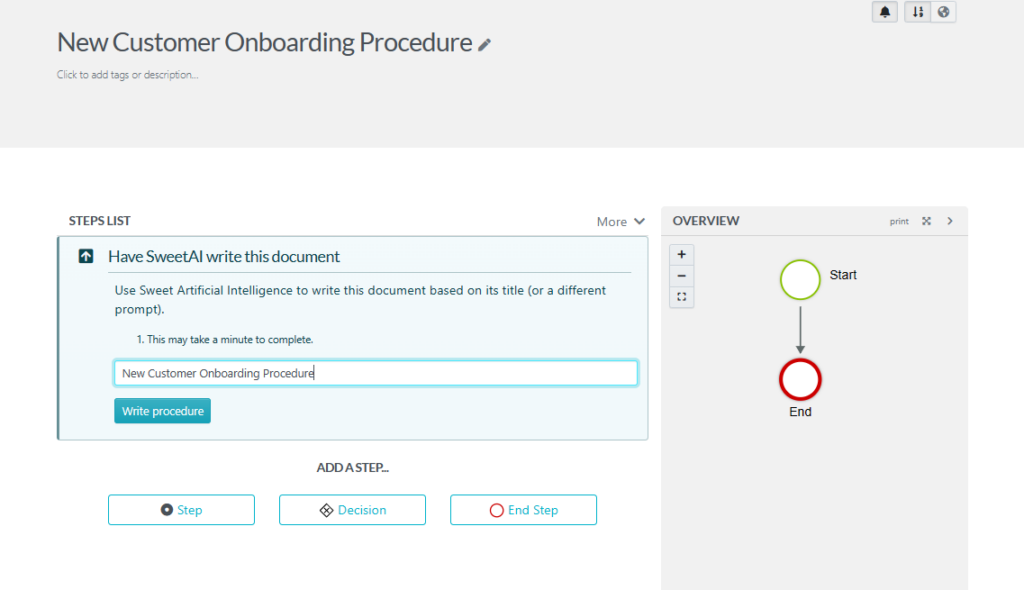
- Once you’ve created your procedure, you can assign it as a task in your onboarding checklist. On the dashboard, click the three horizontal buttons, click “Assign” next to the procedure, and select the appropriate team member or department.

- Repeat this process for each step of your onboarding process, creating procedures for things like “IT Setup,” “Job-Specific Training,” and “30-Day Review.”
For example, let’s say you have a procedure for “New Hire Paperwork” that includes steps like “Complete W-4 Form,” “Sign Non-Disclosure Agreement,” and “Enroll in Benefits.” By assigning this procedure as a task in your onboarding checklist, you can ensure that every new hire completes the necessary paperwork promptly.
Similarly, you might have a procedure for “First Week Check-Ins” that includes steps like “Meet With Manager,” “Shadow Team Members,” and “Set Initial Goals.”
Empower employees with your company’s procedures and processes
A procedure is a set of step-by-step instructions for completing a specific task or activity. It outlines the “how-to” of a particular job function.
On the other hand, a process is a higher-level overview of how multiple procedures or tasks fit together to achieve a larger goal or objective. It outlines the “what” and “why” behind related tasks. It helps employees understand how their responsibilities contribute to the bigger picture.
By documenting and sharing these important resources with new hires, you can help them quickly become familiar with how things are done in your organization.
For example, let’s say you have a “Submitting an Expense Report” procedure outlining the steps an employee needs to take to request reimbursement for work-related expenses. When you share this with new hires during onboarding, you ensure they understand the process from day one and avoid any confusion or delays.
To create a process:
- Navigate to the “Processes” tab in your SweetProcess account.

- Click the “Create Process” button in the top right-hand corner of the page.

- Give your process a clear, descriptive title reflecting its objective or goal.

- Select the team or teams to which the process belongs. This helps ensure that the right people can access the information they need.
- Click “Continue” to move to the process description page.
- Add a brief overview of the process, outlining its purpose, scope, and any key stakeholders or resources involved.
- Start building out the process by adding the individual procedures or tasks that make it up. Include a clear title, detailed instructions, and any necessary resources or attachments for each procedure.
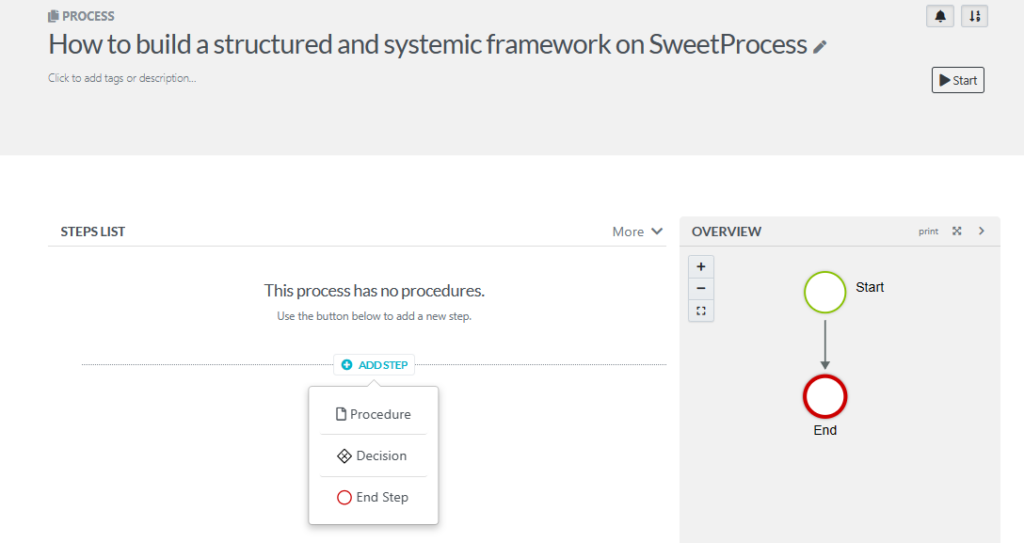
- Use SweetProcess’s drag-and-drop interface to arrange the procedures in the order they need to be completed.
- Once you’ve added all the necessary procedures and details, click “Save” to create your process.
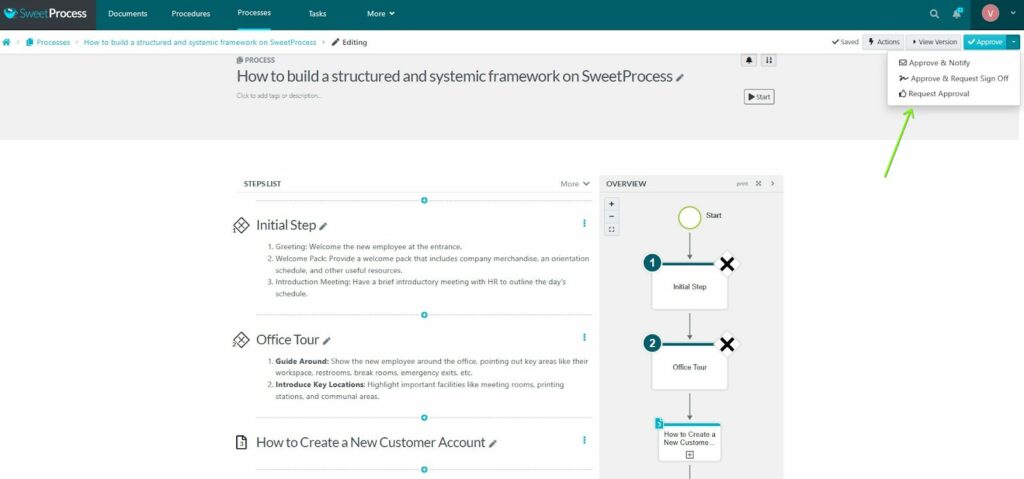
How to Ensure a Seamless and Positive Onboarding Process Experience
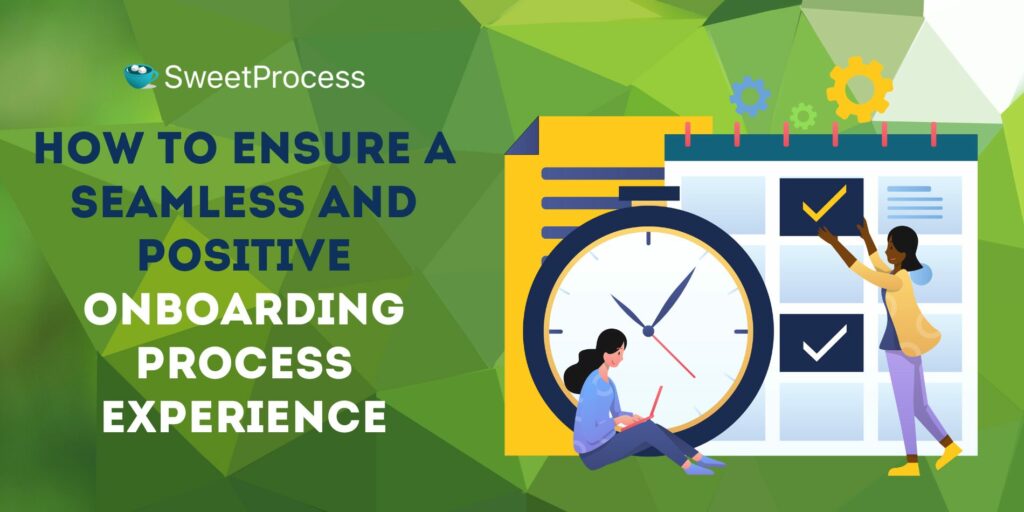
To create a positive onboarding experience, you need to go beyond a warm welcome. It involves a series of ongoing actions that make new hires feel valued, supported, and empowered to succeed in their roles.
Here’s how to create a seamless and positive onboarding experience:
1. Provide resources and learning opportunities
Equip your new hires with the tools and knowledge they need to thrive.
Provide access to training materials, online courses, mentorships, or job shadowing opportunities.
Also, continuously offer learning opportunities that align with their career goals and aspirations. For example, provide new hires with:
- Job-specific training and workshops
- Access to online courses or learning platforms
- Mentorship or coaching programs
- Regular feedback and guidance from managers and peers
A culture of continuous learning fosters growth and keeps employees engaged.
2. Align performance expectations
Communicate their role’s specific goals, objectives, and key performance indicators (KPIs).
Ensure they understand how their work contributes to the team’s and company’s success. A clear understanding of expectations fosters a sense of purpose and direction.
3. Recognize and celebrate milestones
Acknowledge and celebrate the new hire’s achievements, both big and small. This could involve public recognition, a congratulatory email, or a small reward.
Celebrating milestones reinforces employees’ sense of accomplishment and makes them feel valued by the company. Employees who feel valued and appreciated are 67% more engaged.
Positive reinforcement boosts morale and encourages them to continue their efforts and strive for excellence.
For example, you can organize a team lunch or happy hour to celebrate the completion of their first project.
4. Set performance metrics and goals
Employees work well when they have a goal to aim for. Establish measurable performance metrics and goals for new hires.
This gives them a clear roadmap to success and helps them track their progress.
Next, regular performance reviews should be set up to assess their achievements against these metrics and identify areas where additional support or training might be needed.
5. Perform regular check-ins
Finally, one of the most important things you can do to ensure a positive onboarding experience is to perform regular check-ins with new hires throughout the process.
This might include:
- Daily or weekly one-on-one meetings with their manager
- Regular team meetings
- Periodic performance reviews or progress reports
- Informal coffee chats or lunch meetings with colleagues
These check-ins can be formal meetings or informal conversations, but the goal is to create an open line of communication. Ask for their feedback on the onboarding process and seek their input on improving it.
You can use SweetProcess’s quiz feature to set up quizzes to assess the new hire’s understanding of company policies, procedures, and role-specific knowledge. These quizzes can be fun and interactive, gauging their progress and identifying areas where additional support may be needed.
10 Best Practices for a Successful New Employee Onboarding Process
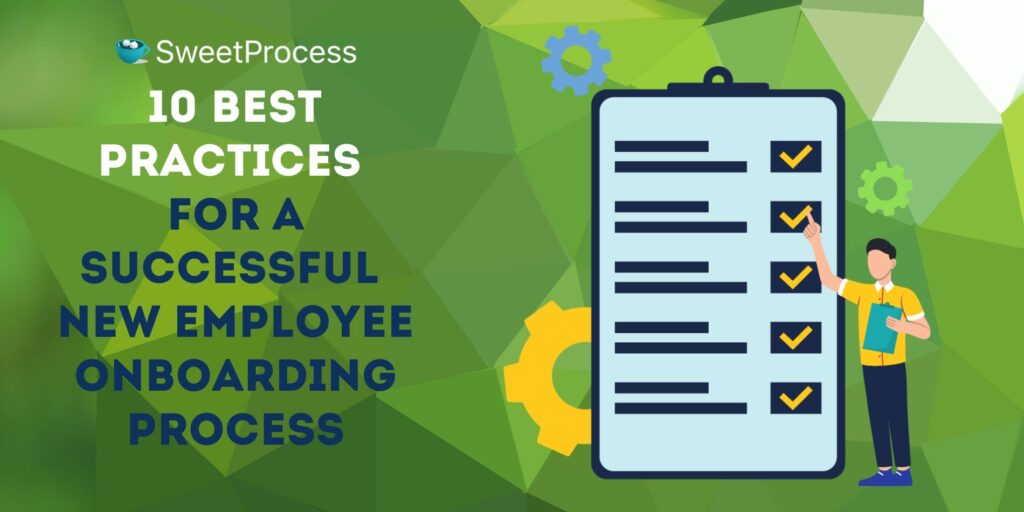
What are some of the best practices you can implement to ensure that your onboarding process is efficient and effective and leaves a lasting positive impression on your new hires?
1. Ensure that the job matches the job description and vice versa
One of the most important best practices in onboarding is ensuring that the job responsibilities match what was outlined in the job description. This helps set clear expectations and avoids any confusion or disappointment.
For example, if the job description emphasizes strategic planning but the actual role is more focused on day-to-day operations, the new hire may feel misled or unprepared. By accurately representing the role and responsibilities upfront, you can help ensure a better fit and a smoother transition.
2. Automate and personalize the onboarding process
Automating routine tasks like paperwork and system access will help streamline the onboarding process and save time for more valuable activities like training and relationship building.
For example, when you create your knowledge base using SweetProcess, you can easily automate sharing important information with new hires.
Instead of manually sending out documents or links, you can add them to your knowledge base and assign them to the appropriate team members or roles.
3. Use an end-to-end onboarding schedule and stick to it
Develop a comprehensive onboarding schedule that spans the first few weeks or months of employment.
Outline key milestones, training sessions, meetings, and activities. This structured approach helps new hires understand the onboarding process and sets clear expectations for their progress.
Ensure that they follow this schedule and that any deviations are communicated clearly.
4. Provide all the tools they need to do their job
Ensure new hires can access all the tools, resources, and equipment to perform their jobs effectively. Set up their workspace and provide computers, phones, software, and other relevant materials.
A well-equipped employee is a productive employee.
5. Conduct a meet and greet
Organize a meet-and-greet event where new hires can interact with their colleagues in a relaxed and informal setting.
Arrange for things like a team lunch, a welcome breakfast, or a virtual coffee break. Encourage introductions, icebreakers, and casual conversations to help new hires build rapport with their team members.
6. Avoid an isolating onboarding experience
While it’s important to give new hires time to learn and absorb information, it’s equally important to avoid an isolating onboarding experience.
Make sure to build plenty of opportunities for interaction, collaboration, and feedback throughout the process.
7. Measure onboarding metrics
Track key onboarding metrics like time-to-productivity, retention rates, and new-hire satisfaction to help you identify areas for improvement and optimize your process over time.
You can also gather data and insights from surveys, assessments, and other feedback mechanisms.
For example, send new hires a survey at the end of their first week, month, and quarter to gauge their experience and identify any challenges or concerns.
8. Incorporate job shadowing
Job shadowing is where the new employee observes and follows a skilled employee to gain practical knowledge and hands-on experience.
It also helps new hires build relationships and networks within the organization.
9. Stay true to your organizational culture
Be authentic and transparent about what makes your organization tick. Share stories, traditions, and rituals that exemplify your culture.
Encourage new hires to participate in company events and activities to experience the culture firsthand.
10. Ensure a consistent onboarding process
Consistency is key to a successful onboarding program. Develop standardized processes and checklists to ensure all new hires receive the same information, training, and support.
This helps maintain a high level of quality and reduces the risk of errors or omissions. Regularly review and update your onboarding process to ensure it remains relevant and effective.
Common Challenges You Might Encounter During the Employee Onboarding Process
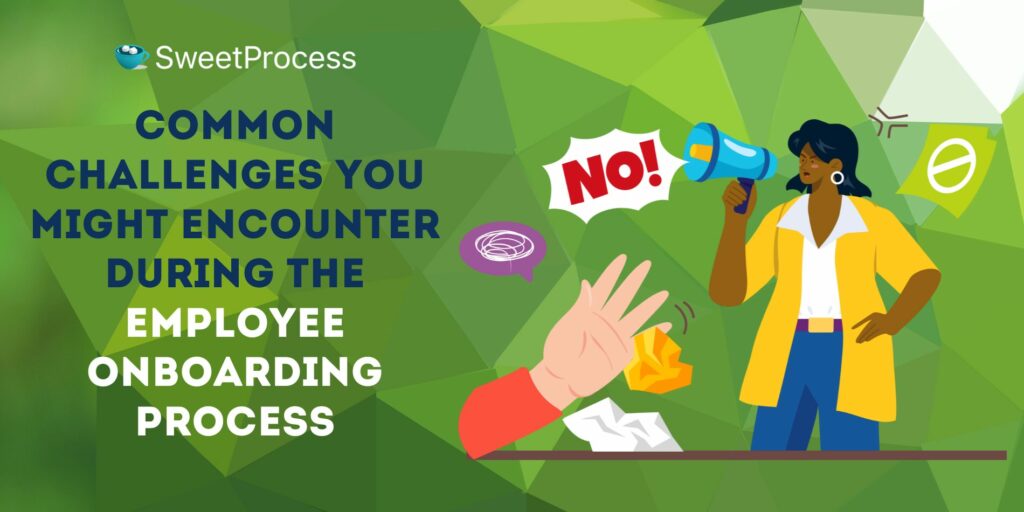
A well-designed onboarding process will set your new hires up for success. However, many companies face several common challenges along the way.
If you’re aware of these potential obstacles and proactively address them, you can create a smoother, more effective onboarding experience for everyone involved.
1. Information overload
One of the most common challenges in onboarding is information overload. New hires are often bombarded with information quickly.
This is overwhelming and makes retaining and applying what they’ve learned difficult.
To avoid information overload, break up your onboarding content into smaller, more digestible chunks. Use a variety of formats, like videos, interactive modules, and hands-on activities, to keep new hires engaged and help them absorb the training material.
For example, don’t try to cover everything in a single day or week. Spread your onboarding program over several weeks or months with regular check-ins and assessments.
2. Lack of role clarity
Another common challenge is a lack of role clarity. If new hires don’t clearly understand their job responsibilities, expectations, and how they fit into the larger organization, they will struggle to be productive and engaged.
3. Not implementing role-specific onboarding
A one-size-fits-all approach to onboarding is ineffective and leaves new hires unprepared for their specific role.
It’s important to tailor your onboarding program to each position and department’s unique needs and requirements.
For example, how you onboard a customer service representative differs from how you onboard a software engineer. Customer service representatives need extensive communication skills, product knowledge, and conflict resolution training, while software engineers require in-depth technical training in specific programming languages and tools.
4. Providing accurate and up-to-date information
Keeping your onboarding information and materials accurate and up-to-date can be challenging, especially in fast-growing or rapidly changing organizations.
Outdated or incorrect information can lead to confusion, mistakes, and a poor experience for new hires.
The Belvidere Community Unit School District 100 case study serves as a cautionary tale for organizations that fail to provide accurate and up-to-date information during the onboarding process.
Before implementing SweetProcess, the district struggled with a disorganized and ineffective system for managing its standard operating procedures (SOPs), and they risked not being compliant with regulatory requirements.
Important documents were scattered across various platforms, such as Google Docs and Microsoft Word, making it difficult for team members to find and access the needed information. This lack of centralization led to confusion, inefficiency, and a poor onboarding experience for new employees.
5. Asking for feedback
A lack of feedback can leave new hires and HR professionals in the dark about the effectiveness of the onboarding process. Without insights into what works and what doesn’t, it’s difficult to identify areas for improvement and enhance the experience for future hires.
Employee Onboarding Process Template: What You Need for a Successful Onboarding
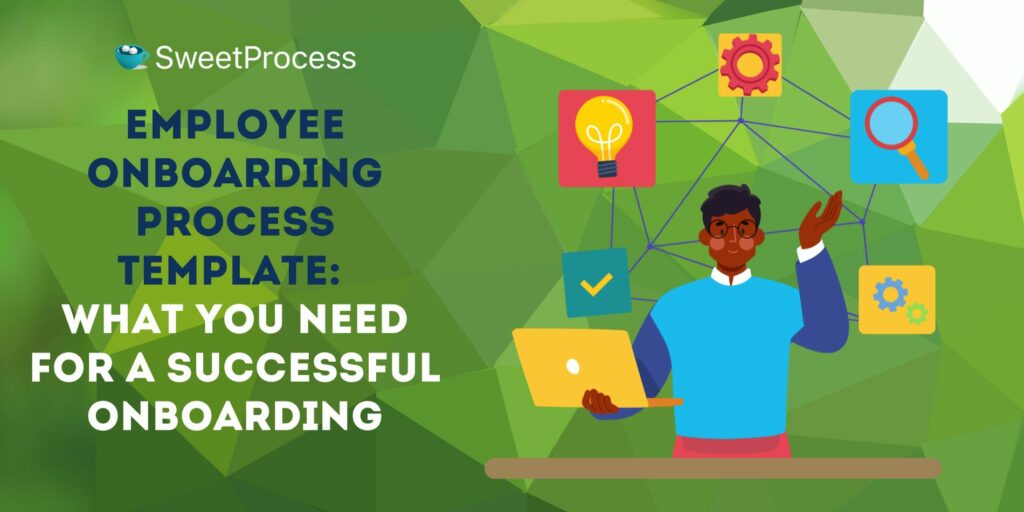
Each organization’s onboarding process will be unique, but we created a few templates you can adapt to fit your specific needs and culture.
Template 1: General Onboarding Checklist
This template gives you a broad overview of the essential steps in onboarding new hires, regardless of their role or department.
You can use this as a starting point for developing more tailored onboarding plans for specific positions.
| Phase | Activities | Responsible Party |
| Pre-Onboarding | -Send welcome email and company information -Provide access to online resources and training modules -Assign a buddy or mentor -Schedule pre-onboarding meetings | HR |
| First Day | -Office tour and introductions -Welcome lunch or coffee break with the team -Review of company policies and procedures -Setting up workspace and equipment -Initial goal-setting and performance expectations discussion | HR/Manager |
| First Week | -Department-specific training and introductions -Meetings with key stakeholders and cross-functional teams -Team-building activities -Completion of any remaining paperwork | Manager |
| First Month | -Regular check-ins with manager and mentor -Participation in company events and activities -Ongoing training and development -Feedback and self-assessment opportunities | Manager/Mentor |
Template 2: Role-Specific Onboarding Checklist
You can customize this template for specific roles or departments. It outlines the specific tasks, training, and resources needed for new hires to be successful in their positions.
| Phase | Activities | Responsible Party |
| Pre-Onboarding | -Role-specific welcome email and information -Access to relevant online resources and training modules -Introduction to a role-specific mentor -Pre-onboarding meetings focused on the specific role | HR/Manager |
| First Day | -Introduction to team members and key stakeholders in their department -Review of role-specific policies and procedures -Set up workspace and equipment specific to their role -Detailed discussion of role-specific goals and expectations | Manager |
| First Week | -Intensive role-specific training -Shadowing experienced colleagues in their roles -Meetings with relevant teams and project introductions -Completion of any role-specific certifications or training | Manager/Mentor |
| First Month | -Regular check-ins with the manager and mentor focused on role-specific challenges -Participation in relevant team meetings and projects -Ongoing role-specific training and development -Feedback and self-assessment specific to their role’s performance metrics | Manager/Mentor |
Template 3: 30-60-90 Day Onboarding Plan
The 30-60-90-day plan breaks down the new hire’s first three months on the job into clear goals, milestones, and activities.
| Timeline | Activities | Metrics |
| 30 Days | -Complete new-hire paperwork and orientation -Meet with manager to discuss role expectations and goals -Shadow teammates and attend relevant meetings -Complete initial training on company tools and processes -Begin working on small projects or tasks -Have regular check-ins with the manager and mentor | Task completion, feedback |
| 60 Days | -Take on more complex projects and responsibilities -Attend additional training sessions or workshops -Participate in team-building activities or events -Provide feedback on the onboarding experience so far -Set goals and development plan for the next 30 days -Continue regular check-ins with the manager and mentor | Project contributions, performance reviews |
| 90 Days | -Fully integrate into the team and take on a regular workload -Identify areas for continued learning and development -Participate in a 90-day performance review with the manager -Provide feedback on the overall onboarding experience -Transition from new hire to fully contributing team member | Initiative, leadership, goal achievement |
How to Measure the Success of Your Onboarding Process
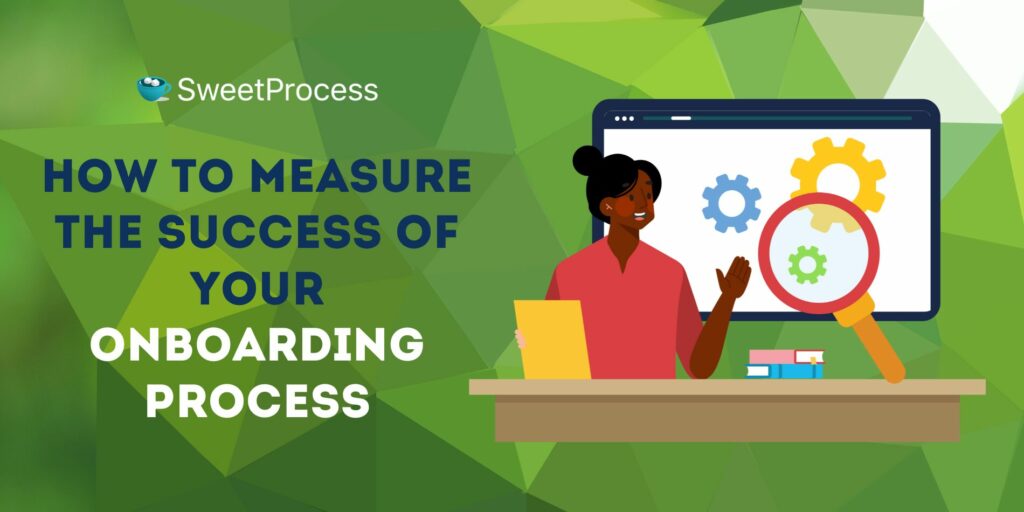
Tracking key metrics and gathering feedback from new hires helps you gain valuable insights into what’s working well and what needs to be adjusted.
Here are four key areas to focus on when measuring the success of your onboarding process:
1. Retention rates and employee satisfaction
One of the most telling indicators of onboarding success is the retention rate of new hires.
Employees leaving within the first few months could signal issues with the onboarding process. Track the number of new hires who stay with the company for at least a year and compare this to your overall turnover rate.
Additionally, conduct regular employee satisfaction surveys, specifically targeting new hires. Ask them to rate their onboarding experience, identify areas where they felt supported, and suggest improvements.
For example, send out an anonymous survey after the first 30, 60, and 90 days of employment, asking questions like:
- On a scale of 1-10, how satisfied are you with your onboarding experience?
- What aspects of the onboarding process have been most helpful for you?
- Are there any areas where you need additional support or resources?
2. Time for productivity and job learning
Next, measure how long it takes new hires to reach full productivity in their roles. This will vary depending on the job’s complexity, but it’s a good indicator of how quickly they learn and adapt to their responsibilities.
For example, a Pluralsight study found that software engineers’ time to productivity falls into three to four months and 11 to 12 months categories. This varies for different roles.
You can also use an onboarding tool like SweetProcess to track onboarding progress and identify bottlenecks hindering their development.
On SweetProcess, assign a task and measure its completion rate to gauge the efficiency of your onboarding process. Monitor the time taken to complete each task to identify which stages are causing delays or confusion for new hires.
This data helps you know where to streamline processes, provide additional support, or adjust the onboarding timeline to ensure a smoother experience.
3. Employee performance and engagement metrics
Monitor new hires’ performance during their first few months. Compare their performance to established benchmarks or the performance of their peers.
If they are underperforming, it could indicate that the onboarding process failed to prepare them adequately for their role.
Employee engagement surveys can also provide valuable insights into how connected new hires feel to the company and their work. High engagement scores suggest a positive onboarding experience, while low scores may indicate areas for improvement.
4. Assessing the overall onboarding experience
Finally, to get a holistic view of your onboarding process’s success, it’s important to gather feedback from new hires on their overall experience.
Do this through surveys, focus groups, or one-on-one conversations with HR or management.
Some key questions you can ask include:
- What did you find most helpful or valuable about the onboarding process?
- Were there any aspects of the onboarding process that were confusing, overwhelming, or ineffective?
- Do you feel the onboarding process adequately prepared you for your role and integrated you into the team?
- What suggestions do you have for improving the onboarding experience for future new hires?
Onboard New Employees Seamlessly Using SweetProcess
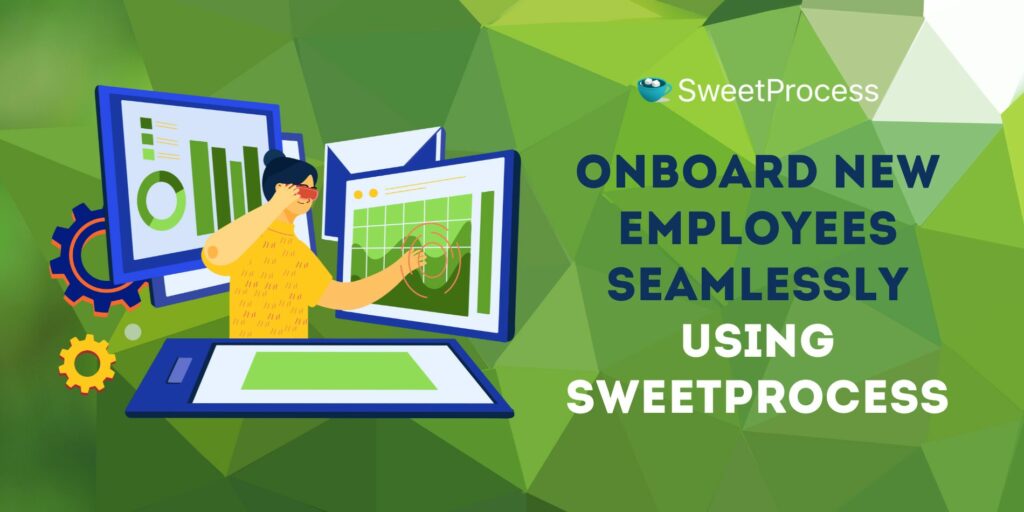
A comprehensive and effective onboarding process prepares new hires for long-term success and seamlessly integrates them into your organization’s culture and workflows.
However, designing and implementing a successful employee onboarding program can be challenging, especially if you lack the right tools and resources. It’s even more cumbersome if you try to do it manually.
But with SweetProcess, our intuitive and user-friendly platform, it’s easy to create, manage, and optimize your onboarding process all in one centralized location.
With SweetProcess, you can:
- Develop and document your onboarding procedures and workflows
- Create a centralized knowledge base of training materials, policies, and resources
- Assign and track onboarding tasks and milestones for each new hire
- Gather feedback and insights from new employees to improve your process continuously
- Integrate with your existing HR and communication tools for a seamless experience
Sign up for a 14-day free trial today and experience how our platform can improve your onboarding process.
